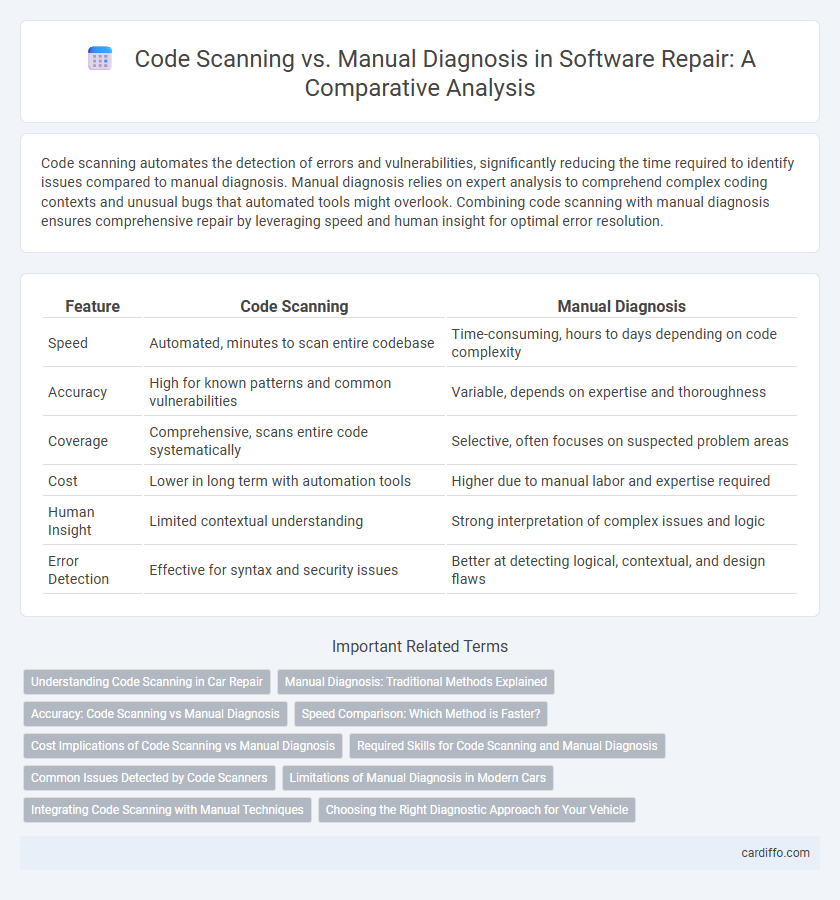Code scanning automates the detection of errors and vulnerabilities, significantly reducing the time required to identify issues compared to manual diagnosis. Manual diagnosis relies on expert analysis to comprehend complex coding contexts and unusual bugs that automated tools might overlook. Combining code scanning with manual diagnosis ensures comprehensive repair by leveraging speed and human insight for optimal error resolution.
Table of Comparison
| Feature | Code Scanning | Manual Diagnosis |
|---|---|---|
| Speed | Automated, minutes to scan entire codebase | Time-consuming, hours to days depending on code complexity |
| Accuracy | High for known patterns and common vulnerabilities | Variable, depends on expertise and thoroughness |
| Coverage | Comprehensive, scans entire code systematically | Selective, often focuses on suspected problem areas |
| Cost | Lower in long term with automation tools | Higher due to manual labor and expertise required |
| Human Insight | Limited contextual understanding | Strong interpretation of complex issues and logic |
| Error Detection | Effective for syntax and security issues | Better at detecting logical, contextual, and design flaws |
Understanding Code Scanning in Car Repair
Code scanning in car repair involves using diagnostic tools to read and interpret error codes from a vehicle's onboard computer system, enabling technicians to quickly identify malfunctioning components or systems. This automated process provides precise data on engine performance, emission controls, and safety features, reducing diagnostic time compared to manual diagnosis. Advanced code scanners support real-time monitoring and comprehensive fault analysis, improving repair accuracy and vehicle reliability.
Manual Diagnosis: Traditional Methods Explained
Manual diagnosis in repair relies on expert technicians using systematic observation and hands-on testing to identify hardware and software faults. Traditional methods involve step-by-step troubleshooting, including visual inspections, component testing with multimeters, and analyzing error patterns based on experience. This approach ensures precise fault isolation and tailored repair solutions, especially when automated code scanning tools lack contextual sensitivity.
Accuracy: Code Scanning vs Manual Diagnosis
Code scanning leverages automated tools to detect vulnerabilities with high precision, reducing human error and increasing consistency in identifying security flaws. Manual diagnosis relies on expert analysis, which can uncover complex issues that automated scans might miss but is subject to variability based on the inspector's experience. Combining code scanning with manual diagnosis optimizes accuracy by balancing thorough automated detection and nuanced human insight.
Speed Comparison: Which Method is Faster?
Code scanning automates the detection of errors and vulnerabilities, significantly reducing the time needed compared to manual diagnosis. While manual diagnosis relies on human expertise and can take hours or days depending on code complexity, code scanning tools typically complete analyses in minutes. This speed advantage enables faster identification and resolution of issues, accelerating the overall repair process.
Cost Implications of Code Scanning vs Manual Diagnosis
Code scanning significantly reduces labor expenses compared to manual diagnosis by automating the identification of bugs and vulnerabilities, enabling faster turnaround and higher volume analysis. Manual diagnosis incurs higher costs due to the intensive time requirements and specialized expertise needed for thorough code reviews. Investing in advanced code scanning tools can lower long-term maintenance costs by catching defects early and minimizing expensive post-deployment fixes.
Required Skills for Code Scanning and Manual Diagnosis
Code scanning requires proficiency in automated tools such as static application security testing (SAST) and dynamic analysis, alongside strong knowledge of programming languages and security vulnerabilities. Manual diagnosis demands advanced problem-solving skills, deep understanding of software architecture, and the ability to interpret complex error logs for accurate fault identification. Both approaches benefit from expertise in debugging techniques and software development lifecycle awareness to efficiently pinpoint and resolve issues.
Common Issues Detected by Code Scanners
Code scanners efficiently detect common issues such as syntax errors, buffer overflows, and SQL injection vulnerabilities, which are often overlooked during manual diagnosis. These automated tools analyze large codebases quickly and consistently, uncovering coding standard violations and potential security risks with higher accuracy. Manual diagnosis typically misses subtle bugs in complex code paths that code scanners highlight through pattern recognition and static analysis techniques.
Limitations of Manual Diagnosis in Modern Cars
Manual diagnosis in modern cars is limited by the complexity of advanced electronic systems and integrated sensors that require specialized diagnostic tools. Relying solely on technician experience can lead to missed or incorrect fault detection due to hidden error codes and software-related issues. Code scanning identifies precise error codes and system malfunctions swiftly, providing a more reliable and efficient repair process.
Integrating Code Scanning with Manual Techniques
Integrating code scanning with manual diagnosis enhances repair accuracy by combining automated vulnerability detection with expert analysis of complex code logic. Code scanning tools quickly identify known patterns and security flaws, while manual techniques provide contextual understanding for nuanced bugs and false positives. This hybrid approach optimizes defect localization and accelerates the repair process, improving software reliability and security.
Choosing the Right Diagnostic Approach for Your Vehicle
Code scanning offers precise identification of error codes and sensor data from your vehicle's onboard diagnostic system, enabling a faster and more accurate problem detection. Manual diagnosis leverages the technician's expertise to interpret symptoms that may not trigger error codes, essential for complex or intermittent issues. Selecting the right diagnostic approach depends on the vehicle's make, model, age, and the nature of the problem for efficient and cost-effective repair.
Code scanning vs manual diagnosis Infographic

 cardiffo.com
cardiffo.com